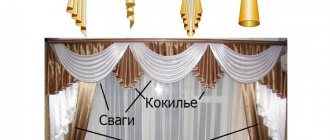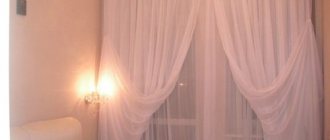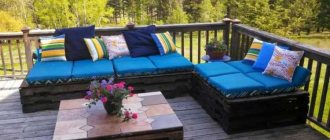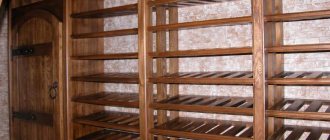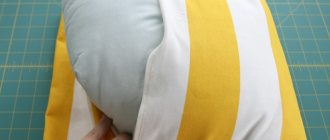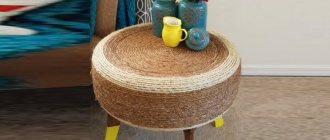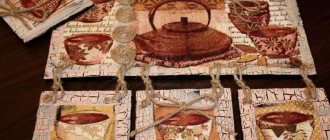Today you won’t surprise anyone with ordinary curtains framing a window opening. But an openwork lambrequin, made with your own hands, will help not only visually enlarge the window opening and cover up the imperfections of the cornice, but will also add lightness, complement the interior with originality and give it completeness. An interesting and sophisticated openwork pattern is the embodiment of elegance and a sense of style, which is advantageously used to decorate a room.
Do you use lambrequins to decorate curtains?
Yes
46.53%
No, I plan to make it
53.47%
Voted: 101
From this article you will learn about the intricacies and secrets of creating an additional curtain decor with your own hands - an openwork lambrequin. Selecting the type of product and suitable fabric, a list of necessary tools and a detailed sequence of the process - this is discussed in detail in the article.
What are lambrequins?
The word "lambrequin" has French roots and means "carved decoration." The item itself looks like a heavy drapery placed across the window, at the top of the frame.
Since ancient times, complex and openwork ornaments and lace patterns have been used in interior design to give it a special charm and sophistication.
Supplements usually include:
- fringe;
- brushes;
- ribbon;
- ruffles;
- eyelets;
- waves;
- braid.
Wide range of options for choosing configurations, colors and shapes makes it possible to create hundreds of different design options.
The main use of this element in the interior is aesthetic. The lambrequin covers the cornices and the empty space between the two panels, which completes the design of the window.
Depending on the style and design of the room, you can choose a suitable pattern, or create an original project yourself.
Additional information: Using a lambrequin you can also visually reduce or increase the window opening. It all depends on how high or low it is hung, what shape it has.
Depending on the style and design of the room, you can choose a suitable pattern, or create an original project yourself.
Windows decorated with carved lambrequins look sophisticated. The patterns look especially bright in combination with a simple light-colored fabric. There are many easy options for making your own decorations.
Window decor with openwork elements will add zest to your interior.
Photo
Help the site, share with friends

Let's discuss this article together:
Click to cancel reply.
How to sew an openwork lambrequin with your own hands?
If you have the time and energy, you don’t have to go to a special store - you can decorate the house yourself. The main advantage of this type of product is its ease of manufacture and maintenance. Even a beginner can sew openwork lambrequins. The first step is to choose a base - the ideal solution would be a self-adhesive bandeau base.
First, take a bandeau - a rigid base, which is sealed on the front side with curtain fabric.
Attention! The material must be handled very carefully. The smallest inaccuracy can spoil the final result.
For sewing you will need:
- main material;
- lining;
- thermal bandeau;
- cords and fringe;
Decorating ordinary items with fringe completely changes their appearance, turning things into unusually beautiful and stylish accessories.
- thread of the desired color;
- whatman;
- scissors.
Tools and materials.
Next, you need to use step-by-step instructions to complete the job correctly. An important decision is the choice of a sketch for the future decorative element.
On the Internet there are a large number of interesting offers for openwork lambrequins with photos.
The quick manufacturing guide includes several steps.
- We are preparing the pattern. We transfer the selected pattern to whatman paper and cut it out.
- We attach the resulting stencil to a heat-resistant fabric - a bandeau.
- We decorate the resulting product with the main fabric, laying it on top.
- We attach the lining to the wrong side using glue webs.
- We sew a zigzag stitch along the edge, adding cord or fringe.
Step-by-step instruction.
Note! You cannot choose natural fabrics - only synthetics. You might think about felt lambrequins. Also, the material should not be friable, since the edges can “fan” over time.
Machine stitching is an inexpensive and accessible processing option.
Processing the edge of the lambrequin with a zigzag
It is also possible to process it with a laser, if such a possibility exists. The only drawback will be the edges of the thermal bandeau, visible from some viewing angles.
Laser cutting is a non-contact method of processing fabrics, allowing you to achieve high cutting accuracy and an absolutely even cut of the material.
A quick method with high-quality results is burning onto fabric. The question of how to cut a figured lambrequin from an unnecessary curtain is solved in exactly this way.
Product patterns can be of varying degrees of complexity - from simple and laconic lines to ornate carved weaves that create a single fantasy pattern.
Materials
The components of the openwork lambrequin are distinguished by the originality of the product and are exemplary high quality materials! It is produced on the basis of fabric bands for curtains “soft” - a matte finish with a light pile, and “shanzelize” - gloss, satin. They are pleasant to touch and easy to clean from dirt and dust. After a long time, they retain the brightness of the colors.
Soft is a curtain fabric with a fleecy coating. It feels like velvet or velor, high density and softness. The surface has a subtle pattern and may appear matte.
Chanzelize is a satin curtain fabric that has two sides, resembles silk when touched, and is smooth. In production, fabric is used only on the glossy side. If you look closely, the structure of the fabric has small stripes that match the tone of the base. Incredibly soft and pleasant fabric with a dense texture, perfectly retains light rays, and is easy and practical to care for.
How to correctly make flowers for lambrequins?
Floral motifs always remain popular, and flowers can add a special charm to the interior of a room. Even a novice needlewoman can make voluminous fabric flowers with a garland of petals. It doesn’t require a lot of costs or materials.
Possibility of masking poorly chosen cornice and architectural flaws of the window opening.
To make it you need to have:
- interlining;
- thin cardboard;
- base fabric;
- glue stick;
- bias tape;
- decorative tape;
- shiny beads;
- a thread;
- scissors;
- iron.
Necessary materials and tools.
First you need a pattern of petals and leaves - at the initial stage we cut out the parts from cardboard. It is best to outline the resulting parts on non-woven fabric with chalk. In total, you will need 3 large petals (calculating the proportions of the lambrequin) and 5 smaller leaves. After this, we begin the main work.
- Apply glue to the non-woven fabric and apply it to the underside of the fabric.
- Carefully cut out fabric blanks for both sides - a total of 6 and 10.
- First, we run a heated iron along one side. When the product holds tightly, use a glue stick and apply the second part of the fabric.
- Next, you will need to decorate the edges with trim to remove imperfections.
- When each piece is glued and processed, we move on to assembly.
Decorates the curtain composition, acting as an exclusive addition that gives the window design a bright personality.
When collecting a flower, we will try to use our imagination. We connect the three petals with a thread, covering the junction with a bunch of decorative tape. We fasten the leaves with a double-stitched ribbon and add beads on threads. You should get an elegant leafy garland. For splendor, you can omit several ribbons without foliage.
A variety of shapes, designs and colors allows you to choose a bandeau model for any interior.
Important! You should pay attention to the color scheme. The edging of the flower should match the color of the ribbons.
Beautiful ideas for decorating windows in the interior
Typically, in wide rooms, models with a variety of decorative elements are used. The more complex the design, the fewer patterns there should be on the material, otherwise you can overload the interior of the apartment.
The bandeau model is the least “whimsical” type of rigid lambrequin. It is suitable for different window openings and doors. When choosing, you need to pay attention to the width.
Interesting ideas for decorating windows in rooms
If there is too little light in the room, then you can purchase transparent material that will ideally transmit daylight.
You might be interested in this: How to choose color and fabric for tulle voile
Note! Classic fabric models are very popular. However, they require special care. For those who don’t have time for this, you can choose openwork and figured models. They are attached to the cornice using self-adhesive tape.
What are the features of a double openwork lambrequin?
Figured lambrequins can be fixed on top of ordinary ones, which gives the overall picture a special flavor. Regarding the shade, it is better to create a sharp contrast between the background and the patterned decor. If you have a regular fabric decoration, you just need to secure the openwork part on top. You will need to ensure that the pattern for the second layer fits well with the rest of the interior solutions for the windows.
The designs of the products can be simple, with laconic, clear lines, or complex, with ornate carved interweavings of a single fantasy pattern.
You can find a lot of monograms, ornaments and stencils for lambrequins to create your own style. The types of window decorations, often consisting of several parts, are striking in their diversity.
The value of handmade products is undeniable: they are true works of art.
The whole picture usually consists of details such as:
- swag (a sagging piece of fabric with gathers);
- jabot (fabric cascade falling along the edge);
- tie (lancet horizontal folds);
- puffs (lush and puffy patterns);
- mold (central element having an acute angle).
The presented products can be made from a set of the following elements.
Note! You should always combine elements in such a way that bright, eye-catching colors do not outweigh calm tones.
Imperial curtains
Such curtains are used to decorate windows. Creating a rich and pompous style, imperial curtains are not suitable for every interior. Being stationary, they are often complemented by Roman curtains or blinds. Such curtains are suitable for rooms with high ceiling heights.
It is best to sew curtains in this style from thick fabric that does not allow light to pass through. Velvet, plush, jacquard are ideal.
Before sewing curtains with your own hands, you need to decide what configuration will be implemented, how many trims will be on the curtain.
Let's look at the step-by-step construction of patterns for different options.
Curtains with one trim
To construct a pattern from point (∙) A downwards, set aside the height of the curtain in its finished form plus 20 cm for the top and bottom folds.
From A to the right we set aside the value AB, equal to the width of the straight part of the curtain, multiplied by K (drapery coefficient). Usually it is taken from 2 to 2.5.
From B to the right we set aside the width of the draped part of the curtain, multiplied by K.
From B and C we draw perpendicular lines down. On them we set aside the length of the draped part, obtained by measurement. This is the height of the cuts, determined according to your wishes. In the drawing BG = VG1.
We find point P as the middle of the segment GG1.
From P with radius RG1 we draw an arc. The position of point G2 is determined by the size of the main sag VG, which depends on your desire. Measurement of VG2 = VG.
From Г and Г2 with radius ГГ1 we draw two arcs. At their intersection we place point C.
From C with radius GG1 we draw the lower undercut of the drapery.
Please note that the accuracy of the resulting drapery depends on the accuracy of constructing the lines VG1G2 and GG2.
When sewing, we tighten the bottom hem of the drapery by carefully tucking it and stitching it with two machine lines, or finishing it with mounting tape.
Next, we grind the assembled part of the lower cut to the side cut of the HD.
We draw the contour of the lower cut DE arbitrarily, according to our wishes.
Curtain with two trims
Let's look at how the pattern is constructed in this case.
We measure the width of the curtain (= the length of the curtain rod) in its finished form - AD. We multiply this size by the drapery coefficient K = 2...3. We calculated the size for pattern A1D1.
We divide this value into 3 equal parts - two undercuts and a flat canvas.
The lengths BE and CF (highlighted in red) are set according to your wishes and are determined by the height of the undercuts.
Set aside B1E1=BE and CF=C1F1.
We complete two rectangles D1E1GC1 and C1F1HD1.
In the middle of segments E1G and F1H we place point M.
From M at an angle of 70° to the horizontal lines we draw straight lines and lay out the segments ME2 = MG and MF2 = MH on them.
With radii ME2=MG and MF2=MH we draw arcs GE2 and HF2.
From E1 and E2 with radius E1G we draw two arcs and at their intersection we place point Z. From this point we draw arc E1E2.
From F1 and F2 with radius F1H we draw two arcs and at their intersection we place point Z. From it we draw arc F1F2.
We received a pattern for a model with two undercuts.
We tighten the undercut E1E2 and sew it in the tightened form to the side line of the curtain B1.
We tighten the undercut F1F2 and sew it in a tightened form to the first undercut along the line F1E2.
There are many options for draping curtains, including the so-called false imperial curtain. The sewing pattern for the ribbon for such a curtain is shown in the diagram below.
How to make a lambrequin from cord and wire?
Sleight of hand and numerous tips on the Internet will help you create an unusual window design. You don’t need to spend a lot of time fiddling around making a lambrequin from a cord. Thanks to its minimalistic appearance, it can become part of a double lambrequin without being excessive. A similar product is created using only 3 basic items: furniture cord, thick paper and wire.
Making accessories using this technique began relatively recently.
- You will need to find the desired sketch and put it on paper.
- Then tightly wrap the wire base with a cord of the desired shade.
- Secure the tips with a glue gun and mask them with strong thread.
Just three years ago, one of the curtain factories proposed and began to implement this idea. - Carefully bend the future product, focusing on the contour of the drawing.
- At the points of contact, sew with small pieces of wrapped wire.
Each specialist began to add something of his own to the idea, inventing new versions of the product.
Important! If the wire is stiff and bending is difficult, you will need pliers. In some places it is difficult to do without this tool.
Austrian curtains
Viennese blinds are a hybrid of Roman blinds and French curtains. When loosened, they turn into a straight canvas, and when raised, they fold into lush folds. Their role is more decorative than functional, since thin translucent fabrics are most often used for sewing.
When thinking about the advisability of choosing such a curtain model, you should take into account all the pros and cons.
Positive points:
- Ease of use. The window opening area is regulated by the tension of the cord;
- versatility in use. Viennese curtains are suitable for the kitchen interior, the living room, and the bedroom;
- comfortable and easy operation. Since lightweight material is most often used for sewing, washing with pre-soaking will always help keep Austrian curtains clean.
Problematic points:
- Given the specifics of the model, there is a certain style limitation. Such curtains require a classic style room. They will also look good in a country or Provence interior. But, in a minimalist or high-tech interior, such curtains should not be used;
- thin fabric will not protect from sunlight and prying eyes when the lamps are on in the evening;
- not the easiest manufacturing process.
To work you need to prepare:
- main fabric;
- fabric for lining (if we make it);
- braid or tape for tightening;
- curtain tape;
- nylon cord;
- cord clips;
- sewing tools.
Description - how to sew Viennese curtains
We start with basic measurements. We measure the height from the cornice to the floor and the length of the cornice. To determine the width of the workpiece, multiply the length of the cornice by two and add twice 3 cm for allowances on each side.
To determine the length of the fabric blank, you need to decide how the curtain will hang on the window. Traditionally, Austrian curtains are gathered up to half the height. If the curtain should be straight when completely unraveled, then the length of its blank is determined by the distance from the cornice to the floor.
To calculate the total length of the cord, you need to determine the length of one gathering strip along the fabric and add the length extending beyond the fabric. And multiply the total amount by the number of assembly strips.
If you plan to use curtain tape instead of cord, then you need to measure the height of the fabric, marked for the gathers, and add allowances for finishing the edges. The resulting number will be equal to the length of the 1st strip.
All measurements and calculations can be systematized in a diagram.
Let's get straight to sewing. We cut out a rectangle from the main fabric according to the required dimensions. It is advisable to steam it first so that the dimensions do not change after washing.
When cutting, add 2-3 cm to the side allowances, 6 cm to the bottom hem. The width of the curtain is 2 - 2.5 times wider than the window opening. Length – 1.5 times the distance from the eaves to the bottom point.
An example of a curtain pattern - see below.
If we use a lining when sewing, then sew it to the wrong side.
Sewing machine
We turn it with a double fold 1.0 - 1.5 cm wide and sew the side allowances. Iron the seam.
We mark the lines of the curtain tape with tailor's chalk. It is she who will create voluminous folds. The width of the sections is 25-35 cm.
According to the markings, we sew the gathering tape with a basting stitch, retreating 3 cm from the top edge.
The gathering tape can be replaced with a regular tape by sewing small plastic rings onto it at intervals of 12 cm. We sew the first rings at a distance of 3 cm from the bottom edge of the curtain.
All pieces of braid must be sewn strictly parallel to the edge of the curtain and to each other. Having checked this, we attach them on the machine.
We process the bottom of the curtain with a double fold of 1.5 cm by 1.5 cm.
We turn the top edge of the curtain to the wrong side twice and baste the curtain tape. We iron it and, making sure that there are no distortions or wrinkles, we machine stitches.
The curtain is hung on a rail cornice. We thread the cords into the rings on the braid and on the cornice. There are ready-made cornices on sale with a special lifting mechanism.
The bottom of the curtain can be decorated using any decorative elements - frills, fringe, braid. If the curtain fabric is thin and light, then it is advisable to make the lower edge heavier by sewing in small weights.
How to sew Austrian curtains from ready-made curtains
We process the top and bottom edges. If desired, decorate the bottom.
We sew the braid along the curtain fabric at the selected pitch. If the width of the canvas is small, two vertical stripes along the edges and one in the center are sufficient. The length of the strips should cover the height of the curtain intended for assembly. The braid is not sewn onto the upper straight part of the curtain.
To form folds, pull the cords to the desired height. At the same time, we straighten the folds, giving them a beautiful look.
If in the future the folds are not intended to be undone, then we tie the cords in a knot and cut off the excess part. And if the folds start to unravel, then you need to tie extensions to the cords and bring them out through the cornice to one side. The second option is to sew a ribbon across the entire height of the fabric.
There is little left to do - hang the curtain on the window.
Using the principle of Austrian curtains, you can sew curtains with a lambrequin. It is sewn in the same way, according to the previous algorithm.
Various beautiful options for Austrian curtains - see below.
How are windows decorated with openwork lambrequin?
Lambrequins are not new to the interior. The opening is designed along the entire length or in separate parts. Intricate corner decor or a standout patterned dome in the center are popular.
Carved decorations on windows often act as a bright accent in window decoration.
As you can see, decorations vary in shape, location and material. Sometimes their appearance seems catchy and unexpected, because imagination decides everything here. However, the constant in the figured lambrequin remains refined elegance.
Thus, making an openwork lambrequin yourself will not be difficult, provided that the cut is precise and neat.
Curtain "Cat's House"
This curtain with an arch is perfect for kitchen windows. Having no gathers along the top edge, it lays down in beautiful folds.
The pattern for such arched curtains for the kitchen is quite simple to construct. First, let's decide on the three main sizes. They are shown in the diagram.
We draw an arc with radius R=C:3, drawing the top of the “Cat House” curtain.
Set aside dimensions A and B. Connect the extreme points with a smooth line.
How to sew curtains for the kitchen
Using the completed pattern, we cut out the curtain blank with allowances. We process the bottom edge by bending the allowance. You can use facing or fringe.
We fold the side sections with a double hem and stitch them. We sew a curtain tape with loops or a drawstring onto the top edge.
Secrets of successful drapery
Curtains and drapes decorated with drapery look especially attractive. For draperies, it is better to choose fabric of solid colors. Soft delicate folds can be created from materials that drape well - cambric, silk, organza, velor.
Curtain tape is a great way to create an even fold across the entire width of the curtain, since the pleat is already built into its structure.
Using draperies made using the swag and jabot method, you can create additional decorative elements.
All these methods will help create an expressive window design and transform even the simplest curtain materials.
French curtain - awning
To make it, you need a special braid, in which the gathers are fixed and do not slide under their own weight.
The dimensions of the workpiece should be 1.5 times the width of the finished part and 2 times its height.
Let's look at sewing a pattern for a French curtain made of crystal.
The dimensions of the finished product are 1.6 x 2.5 m.
Accordingly, the dimensions of the workpiece are 3.75 x 3 m, taking into account rounding and allowances = 4x3 m.
We take the distance between the rows of assemblies to be 50 cm. After simple calculations, we determine that 9 rows require 27 m of tape for assemblies.
For the top, you need another 4 m of braid when making assemblies, and if you plan to lay folds, then you need 2.6 m of braid.
Let's start sewing. We mark the lines for sewing the braid, pulling out at intervals of 50 cm along the thread.
We tie one end of the braid knots with a knot and melt it.
Sew on the braid starting from the bottom edge. If we are going to trim the bottom of the curtain with trim, then we align the braid along the cut of the bottom, and if we are planning a hem, then we attach the braid, taking into account its width.
We attach one edge of the braid, then the second. In this case, the sewing line should be along the axis of the braid.
Repeat for side cuts.
Having sewn all the braids, we turn and sew the bottom seam allowance.
Place folds along the top edge. The original width of the fabric was 4 m, of which 4 cm was used for hems. The remainder is 3.96 m. Having subtracted the width of the finished curtain (= 2.5 m), we determine that there are 1.46 m left for the folds. Divide by 8 and we get 18.25 cm for each fold. Round up to 18 cm. We make a counter fold of 9 cm above each braid, and a simple fold of 9 cm on the sides.
We attach the braid.
We tighten the ribbons to the desired curtain size.
The work is done!
If you wish, the top edge can simply be gathered on the curtain tape.
Types of product and features of its tailoring
A rigid type lambrequin is a fabric strip duplicated with a denser lining material.
For sewing, various fabrics are used along with the main one. In this case, you can use dense fabric if it is pleated, non-woven or any other. This will create the perfect shape for the base.
The finished product must be fixed to the ceiling. In this case, you can use eyelets that are attached to a strip spaced from the cornice.
A hard lambrequin does not require folds, unlike a soft one. If you need to create a lambrequin with your own hands, then you should be especially careful when choosing a suitable fabric. Great attention is paid to the shade of the material and its main tone; it is possible to choose patterned fabric if you make the curtains plain.
Curtain "Cascade"
It is very easy to sew such a curtain with your own hands using patterns based on simple calculations. For calculations we use window measurements: width – 130 cm, height – 150 cm.
We need to build a semicircle with a length equal to the width of the window plus 5 cm for a free position. For us it is 130 cm + 5 cm = 135 cm. To determine the radius, divide this number by 3.14.
By rounding we get 135:3.14 = 43.
Then to the right and left we set aside segments equal to the height of the window, down - the height of the central part of the curtain (= 35 cm). We draw a smooth line through all the points. The “Cascade” curtain pattern is ready!
Using these calculations, you can use similar patterns to make lambrequins for curtains with your own hands. To do this, draw a second semicircle at a distance from the height of the lambrequin.
It is advisable to treat the upper edge of such a curtain with double facing. You can attach rings to it or sew curtain braid.
The bottom edge can be simply tucked in or decorated with a variety of elements - frill, lace, fringe.


